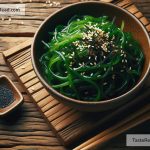In recent years, a surprising ingredient has slowly but surely made its way to the forefront of culinary innovation and household pantries alike: seaweed. Yes, that’s right—the oceanic greenery, once relegated to the realm of sushi rolls and the occasional miso soup, is now taking center stage in kitchens around the globe. But what’s behind this rise in popularity? Let’s dive into the reasons why seaweed is becoming a staple ingredient in modern kitchens.
Health Benefits Galore
One of the primary reasons behind seaweed’s surge in popularity is its impressive health profile. Packed with vitamins (like Vitamin C and Vitamin K), minerals (such as calcium, magnesium, and iodine), and antioxidants, seaweed is a nutritional powerhouse. It’s also an excellent source of dietary fiber, which is great for digestion. Plus, it carries the added benefits of being low in calories and fat, making it a fantastic ingredient for those looking to maintain or lose weight. Its high iodine content is particularly noteworthy, as it’s crucial for healthy thyroid function, which regulates metabolism.
Sustainability Champion
As more people seek to make environmentally friendly choices, the sustainability of seaweed as a food source adds significantly to its appeal. Seaweed farming has a minimal environmental footprint compared to traditional land farming. It doesn’t require freshwater, fertilizers, or land clearance, thus reducing the strain on already scarce resources and avoiding the destruction of natural habitats. Moreover, seaweed cultivation can benefit marine environments by absorbing excess nutrients and CO2, potentially aiding in the fight against climate change. This aspect makes seaweed an attractive option for eco-conscious consumers and chefs alike.
Culinary Versatility
Seaweed doesn’t just skate by on its health and environmental merits; it’s also incredibly versatile in the culinary world. Chefs and home cooks are finding more and more creative ways to incorporate seaweed into their dishes beyond the obvious sushi rolls. From salads and soups to snacks and seasonings, seaweed can add a unique umami flavor—that savory taste that deepens the overall flavor profile of a dish. It’s also available in various forms such as dried, powdered, or fresh, allowing for a range of applications in cooking and baking. Its adaptability makes it easy to include in everyday meals, helping to broaden our culinary horizons.
Cultural Shifts and Global Influences
Globalization has played a significant role in bringing diverse food traditions to the forefront of the culinary world, including the use of seaweed in various cuisines. As people become more adventurous with their eating habits and seek out new and exotic flavors, seaweed has benefited from this cultural shift. The growing popularity of Japanese cuisine, in particular, has helped introduce seaweed to a broader audience. As we become more curious about and accepting of different food traditions, ingredients like seaweed that were once considered niche are now celebrated for their unique characteristics.
Economic Efficiency
Adding seaweed to your diet can also be seen as an economically savvy choice. Given its high nutrient density and versatility, seaweed offers great value for money. For those looking to add more nutrition to their diets without breaking the bank, incorporating seaweed into meals is an excellent option. Its long shelf life, especially in dried forms, means less waste and more bang for your buck.
Conclusion
The rising popularity of seaweed in modern kitchens is a testament to its incredible health benefits, environmental sustainability, culinary versatility, and the global palette’s evolution. As we continue to explore and embrace sustainable food sources that don’t compromise on nutrition or taste, seaweed stands out as a prime candidate leading the way. Whether you’re a seasoned chef looking to innovate your dishes or a home cook seeking nutritious and eco-friendly meal options, seaweed offers a wealth of possibilities. It’s clear that this oceanic ingredient is more than just a passing trend—it’s here to make waves in the world of gastronomy. So, the next time you’re meal planning, consider reaching for some seaweed and discover the myriad of ways it can enrich your culinary experience.


